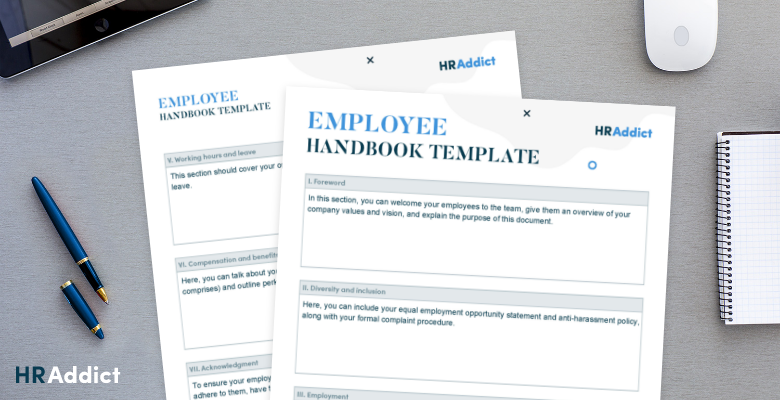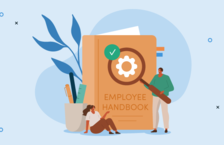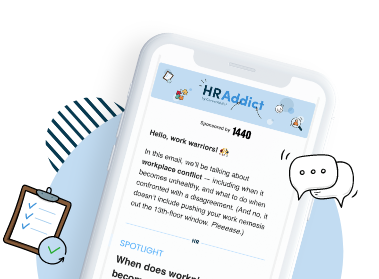A vital tool for any organization, large or small, employee handbooks provide an important connection between its people, culture, values and processes. They’re often given to employees when they start, and they remain an important reference point for them throughout their careers.
Employee handbooks contain a lot of important information and, as such, it’s important to spend time and effort writing them.
This article covers everything that you need to consider when writing your employee handbook, from why they’re beneficial to what is included in them, as well as some best practices for ensuring your handbook makes a lasting impact on your people.
What is an employee handbook?
An employee handbook is a guide that communicate an organization’s culture, policies, procedures and expectations for its staff. It covers a range of purposes, such as informing employees of legislative obligations, less formal company rules, and also telling them a little bit about where they’re working.
They’re designed to be a current source of information and it, therefore, should be updated frequently.
The benefits of an employee handbook
Employee handbooks are an essential part of an organization, mainly because they bring so many benefits to employees and their workplace. Here are the main benefits of having an employee handbook in place.
They establish clear expectations and accountability
Employee handbooks essentially tell the employee what everything is and who does what. It’s a gauge of workplace policies and rules, and their role in promoting them. The handbook also informs employees of their organization’s purpose and managers’ roles and responsibilities.
They promote legal compliance
Employee handbooks should be written in line with local and national legislation. This means that the handbook is a first guard against illegal activity or non-compliance that can put the company at risk of financial or legislative penalties.
They streamline communication
Employee handbooks, if written well, can help to communicate an organization’s culture. They also promote open communication by clearly informing all employees of important information regarding their employment and their workplace.
What to include in an employee handbook
When planning your employee handbook, there are many points to add to ensure it’s useful and communicative. Here are the 10 main elements of an employee handbook that you must include.
Code of conduct
This section serves to communicate the most important workplace rules. It establishes clear guidance on expected behavior and will be aligned with the company culture, as well as laws and standards. It might include what professional behavior looks like, as well as provide business integrity and ethics information.
Company information
This section might also serve as the introduction to the handbook. It will include a brief introduction to the company, its culture and values, and also explain the handbook’s purpose to employees.
This section is usually written on behalf of the company’s leadership and signed off by them. Another section connected to this is a glossary that will explain company terminology or jargon.
Compensation and benefits
This section will include comprehensive information about payroll information (such as pay scales and pay dates), as well as guidance on benefits. This will include health insurance information, paid time off policies, and other workplace perks.
Disciplinary policies
In this section, information regarding disciplinary processes will be shared, such as the investigation procedures, different levels of warnings and termination information, and how to raise complaints and concerns of your own. It might also include performance management information.
Employment policies
Employment policy information will include an overview of the organization’s commitments to regulatory compliance such as employee classification, equal employment opportunity policies and anti-discrimination legislation. The section might direct employees to full workplace policies regarding these points.
Health and safety
This section will communicate health and safety standards to employees, such as what to do in the event of an accident or crisis at work, safety procedures, and reporting workplace hazards or injuries. It will outline the responsibilities of employees, managers and the organization in this regard.
Leave policies
With so many different types of leave on offer for employees, this section outlines these options, such as sick leave, vacation entitlement, and family and medical leave. It will include information on how to request these types of leave and eligibility requirements, if applicable.
Performance evaluation policies
This section introduces employees to how feedback is given in the organization. It will cover probation periods, annual appraisals and the frequency of other regular, formal feedback interventions. It might also include a brief run-through of expected performance standards.
Privacy policies
This section will include how confidential information, such as employee data and personal information, is handled. It might also include a disclaimer advising employees that the information in the handbook is private and not to be shared externally.
Time and attendance information
This section explains attendance expectations and will also inform employees about information such as working hours, break times, overtime policies and flexible working arrangements. It might also combine some elements of the “Leave Policy” section or will be included adjacent to this section to minimize confusion.
How to write an employee handbook
Now that you know about the benefits of an employee handbook and what to include in one, it’s time to start thinking about how to write it. This section covers some top tips for writing your employee handbook to ensure it is effective and useful for everyone in the organization.
1. Keep guidelines simple
When writing an employee handbook, you’ll be wrestling with business jargon, company terminology, and legal language too.
Simplify this language whenever you can to ensure the handbook is understood by everyone and doesn’t discourage people from reading it. Write the language from the point of view of junior or new employees first to maximize its reach and effectiveness.
Consider adding a glossary and a FAQs section to give employees a quick reference option to the document. These sections will add a greater level of accessibility to it as well.
2. Know the applicable laws
Employee handbooks must be 100% accurate. This means that all information needs to be up to date, especially legal references.
When writing an employee handbook, diligently research all the laws that need to be explained to employees. Ensure that you work with industry or departmental experts to ensure that all legal information is correct, and provide a sample for proofreading before it’s published.
The consequences of getting this information wrong can be severe, from putting the company at legal risk to failing to protect the rights of your employees.
3. Make it accessible
It’s vital to ensure that when you write your employee handbook, you make it accessible to everyone in the organization. This will include those employees with disabilities, remote workers and employees with varying levels of the local language.
Provide both print and digital employee handbooks, and consider offering large print copies.
It’s a worthwhile exercise to translate the handbook into various languages if a significant proportion of the employee population might struggle to understand its contents.
4. Obtain employee acknowledgment
Ultimately, the employee handbook is an important reference of information that is essential for employees to engage with and understand. Therefore, it’s advisable to have your employees sign off on the handbook.
You can accomplish this by either a tear-off sheet in printed handbooks or having employees e-sign electronic versions. Keep the sign-off in their employee file, and ensure the handbook is re-signed whenever it is updated.
5. Outline roles and responsibilities
A common pitfall of the employer–employee relationship is that it’s sometimes not clear who is responsible for what. For example, an employee might expect their manager to enroll them in training, whereas a manager might expect the employee to enroll themselves.
In the handbook, set out the key stakeholders, and for each process covered, explain who is responsible for actioning it. The most frequent stakeholders in this respect will be the employer, their manager, the collective company and HR.
Link back to the company intranet as well, where needed.
6. Personalize the handbook to fit your company culture
Format your handbook’s tone, content and visuals to align with your organizational culture. This will reinforce your organization’s vision and provide alignment between its culture and the behavior of employees. It will also demonstrate to them that culture is taken seriously and permeates all levels of the organization.
Whether your organizational culture is formal or more relaxed, choosing a layout and structure that matches this will be noticed by employees and strengthen your employer brand.
7. Start with a clear purpose
When writing an employee handbook, start with the purpose of it upfront. Explain what the handbook serves to accomplish, that it aims to provide employees with a reference to company policies, guidelines and processes.
Add that it is to be used as a first point of contact for most workplace matters and that employees can contact a set department for support if they have questions. The handbook’s purpose can also be combined with a welcome statement to new employees, and is best introduced and signed off by a senior leader such as a CEO.
8. Structure it clearly
Employee handbooks will contain a huge amount of information, and it’s easy for employees to become overwhelmed when reading them, especially if they’re trying to find specific advice on a particular subject.
When writing your employee handbook, take time to use a set template, structuring the handbook into sections that focus on a particular area, such as absence and leave, or conduct. Include an index at the start of the handbook, and consider placing the most frequently asked about subjects (such as compensation and benefits) at the front.
9. Update it regularly
Employee handbooks can go out of date swiftly. This is due to changing policies and procedures, changes to legislation, the company structure being altered, and accessibility needs evolving. Ensure the company handbook is updated to reflect these changes.
A good practice is to coordinate a thorough review of the handbook every year and have it republished and signed off on an annual basis. Nevertheless, impactful changes might necessitate an early revision or, at the very least, an addendum being added to the handbook until it’s more thoroughly reviewed.
10. Use visual aids
Punctuate the inevitable swathes of text in a handbook with visual aids. These can be used to break up sections or help to explain them.
Examples of visual aids to use can be graphs, tables, or icons. Photos are another great visual aid. You can use photos from your organization or even photos of your employees (obtain their permission to use these beforehand).
Consider setting up a competition for employees to submit their own photos to feature in the handbook.
Free employee handbook template
Streamline your employee handbook creation process

Writing an employee handbook from scratch can be a daunting and monumental task — but this free template below lays the groundwork for you. All you have to do is customize it according your needs and company policies!
FAQs about employee handbooks
If you’re looking for some extra guidance on creating an amazing employee handbook, here are three frequently asked questions to help you with the process.
Q: How often should an employee handbook be updated?
There are two good times to update a handbook. Firstly, an annual update can keep the document fresh and current, and it should also be updated as soon as there are significant changes in policies or legislation.
Q: What should be avoided in an employee handbook?
Try to steer clear of overly long explanations of policies and complicated or technical language. It’s also important to avoid writing about assumptions or making promises that the organization will not be able to keep.
Q: What tone or language should be used in the handbook?
Use an accessible and friendly tone that also conveys clarity and professionalism. This ensures all employees can understand the handbook. Use a style of writing that’s in synchronization with your employer brand or organizational culture.
Key takeaways
Employee handbooks are an essential resource for an organization and its people. They can positively impact the workplace in many ways, and it’s essential to have one in place.
Here are some key considerations to think of when preparing your employee handbook:
- Having an employee handbook in place is a win–win. It supports employees and ensures the organization is legally compliant.
- Adding character to your employee handbook through visual aids and aligning it to your culture will help information be retained and ensures organizational messaging stays top of mind.
- Ensure you plan your handbook to avoid omitting important information. Consult with internal and external experts to ensure it’s accurate.
- An employee handbook should be an evolving document; it’s important to keep it updated.
Taking the time to write a compelling, informative and useful employee handbook that’s aligned to your culture will make a positive impact on your employees. Serving your people, your organization and its purpose, it’s too valuable a resource to ignore.
Got a question? Let us know in the comments section below.
This article is a complete update of an earlier version originally published in 2017.

